- Best Overwatch Tank Guide - January 14, 2023
- Valorant vs CSGO Compared - January 13, 2023
- Best Overwatch 2 Settings - January 13, 2023
Valorant is one of the fastest-growing, most exciting games out there on the market right now. Since its release in 2020, the game has taken over the competitive (and casual) gaming scene by storm, with millions of players daily.
Despite all these hours logged on Valorant, one of the biggest questions remain unanswered: The Phantom of the Vandal? As you load into the buy phase with just enough credits to buy a rifle, full armor, and all your utility, you’re left with two rifle options to complete your loadout. So you must pick one: will it be the Phantom or the Vandal?
Bottom Line Up Front
The Phantom has many features like its suppressor and more prominent magazine that’s negated by the damage falling past 15 meters. The Vandal, on the other hand, has worse recoil and a smaller magazine. However, its one-tap potential makes it a favorite amongst highly accurate players.
Choosing one over the other is a matter of personal preference and in-game context. Duelists and controllers may be better off with the Phantom as they seek engagements at high speeds or spam through smokes. Sentinels and initiators may be better off with the Vandal, given their ability to trade no matter the distance.
The Phantom: Key Features
The Phantom in Valorant costs 2,900 credits. It has a 30-round magazine that shoots 11 rounds per second with a 0.2 first-shot spread. The Phantom’s damage is variable and depends on your distance from the target.
The feature that sets the Phantom apart from all the other options is its silencer allowing it to spam through smokes without much risk of giving up the shooter’s positioning.
On top of this, the sound of firing can’t be heard at distances of 40m+ except in the firing direction. I opt for the Phantom when I play Duelist on Attack; it’s easier and safer to shoot off a recon bolt’s ping when you know your enemies can’t trace back the bullets to where you’re standing.
Here are the Phantom’s complete statistics:
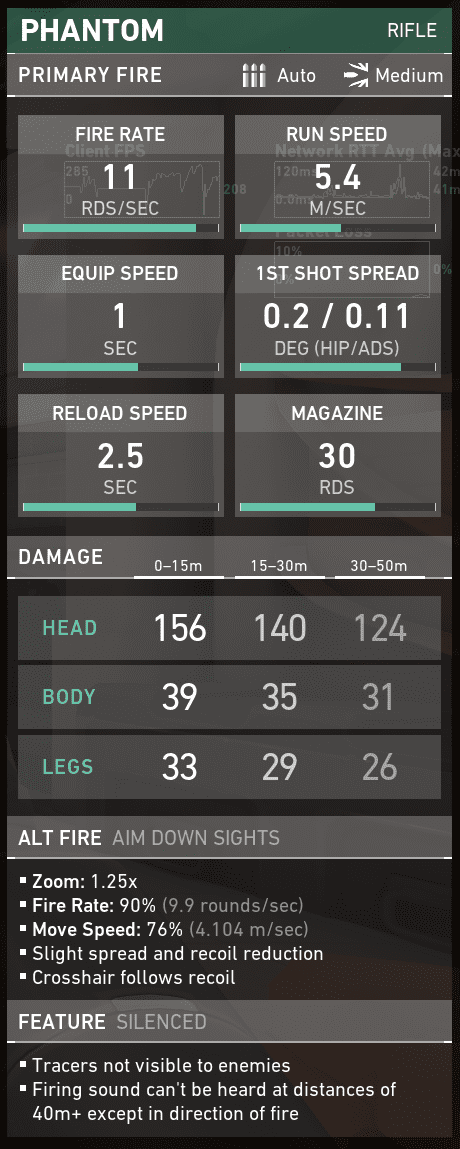
The Phantom remains the best general-purpose weapon in the game, where it excels in close-range combat while remaining above average in long-range shooting battles. Even with the damage fall-off, the Phantom remains a popular choice amongst Valorant players because of its ability to clear close angles and corners that populate many of Valorant’s maps.
If you aim down sight (ADS) with the Phantom, your fire rate and move speed decrease by 90% and 76%, respectively. To compensate for that, aiming down your sight allows you to zoom into your scope by 1.25x while your recoil and spread reduce marginally.
Pros and Cons
| Pros | Cons |
| Silencer | Damage Fall Off |
| Spray Control | |
| 30 bullet magazine |
As I mentioned earlier, the Phantom’s silencer and recoil reset times are some of the most significant advantages that the Phantom has over the Vandal. In Valorant, where many maps are filled with tight corners, the quick recoil reset is a welcome addition to the Phantom’s feature set.
Because of these features, a gun like the Phantom would be handy if you’re looking to constantly spam through smokes or walls, given that the recoil is more manageable than its one-shot headshot counterpart.
Riot Devs have made it a point to introduce damage fall-off to the gun to offset the Phantom’s advantages. From 15 to 30 meters, a headshot with the Phantom will only do 140 damage. From 30 meters onwards, a headshot with the Phantom will only do 124 damage.
The damage difference means that if you’re against an opponent with full armor and a vandal from 15 meters onwards, you’ll need two shots, one to the head and one anywhere else, to kill him, while he’ll only need one shot to your head to kill you. The damage nullifies every advantage afforded by a larger magazine, a silencer, and better spray recoil.
Why does the fall-off damage justify all these advantages? The answer is pretty simple. At the highest level of the game, the top 5% of players have trained their aim and game sense to the point where their first shot is more than likely to be on target: your head.
All things equal, if you give the top players either a Phantom or a Vandal, the player with the Vandal would win out over the Phantom at any distance greater than 15 meters because all it takes is one bullet to the dome for the Vandal player to get the kill.
I’ve gotten “Phantomed” many times in Valorant, especially on the defensive end. As a duelist main, I take first contact for the team, more often than not. I love peeking into the deep angles to get those highly-coveted first picks. Let me be the first to tell you that holding down these long angles with a Phantom is far from optimal. Getting shot down by a Vandal, even though I dinked the enemy first, has been such a common occurrence for me that I’ve decided to switch up how I play as a duelist or change my preferred gun altogether.
Here’s 100Thieves pro player Sean “Bang” Bezerra on the topic:
The Vandal: Key Features
Where the Phantom is an excellent gun for spraying through smoke, the Vandal is its louder, more powerful brother. The Vandal shoots a 25-round magazine at 9.75 rounds per second with a 0.25-degree first shot spread. When you ADS with the Vandal, your fire rate and movespeed also go down by 90% and 76%, respectively.
Like the Phantom, ADS-ing zooms your vision into your scope and reduces your spread and recoil. Vandal users use this alternate firing mechanic much more, as all it takes is one bullet to the head to eliminate a player from the round.
Professional players like C9 Yay have gained significant notoriety for holding angles with the Vandal while ADSed and one-tapping opponents’ heads.
Here are the statistics of the Vandal:
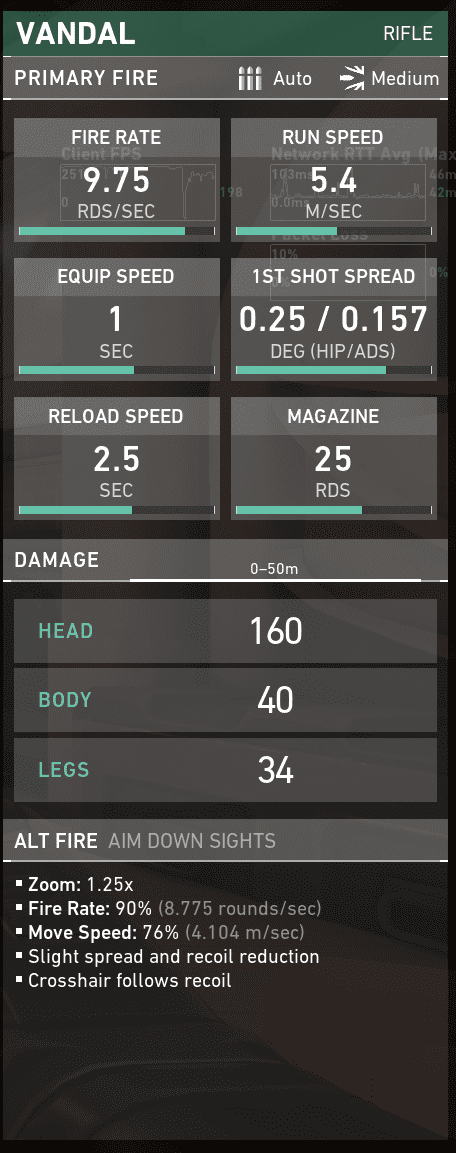
Pros and Cons
| Pros | Cons |
| No Damage Fall Off | Worse Spray Control |
| Perfect For Pre-Firing Angles | No Suppressor |
The best thing about the Vandal is that it has no damage fall off, no matter the range. Say you’re in Ascent, and you have a vandal and fighting someone top mid; a Phantom would require you to hit the enemy twice before you even have a chance of killing him. On the other hand, a Vandal would instantly kill the attacker if you manage to land a headshot.
Now, say you’re on the attack and peeking into A main. If you’ve noticed someone almost always likes to peek early, you might prefer the opponent before he gets a chance to aim at you. Assuming that the distance between where you peek and where the target stands is greater than 15m, you’re more likely to eliminate the enemy with a Vandal than a Phantom.
However, in many other scenarios, the Vandal doesn’t share the same advantage over the Phantom. The Vandal has way worse spray control than his counterpart and is, therefore, a less suitable weapon for 1vX scenarios in higher ranks where enemies have a greater tendency to play together and double peek.
The Vandal’s disadvantage in clutch situations means I often find myself actively searching for a Phantom before I commence the clutch. If I can’t find a Phantom, I make it a point just to burst, strafe, and tap with a Vandal when I’m getting double-peeked.
The lack of a suppressor also means bullet tracers. This makes the Vandal less optimal for spraying through smokes, as the opponents can guess where you’re shooting from based on the bullet’s tracks.
Main Differences
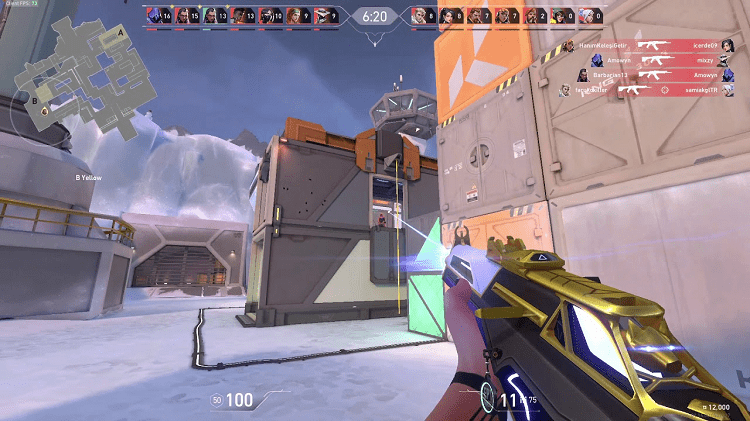
All in all, the Vandal and Phantom have the following differences:
Spray Control
The Phantom has a more compressed spray pattern compared to the Vandal. This means two things:
Gunfights are Easier
CSGO players have always had issues with Valorant’s recoil taking forever to reset. In CSGO, for example, if you whiff the first burst round of your AK-47, you could strafe a little, and your recoil will almost immediately reset.
In Valorant, the reset time is considerably longer. However, the Phantom’s reset time is significantly shorter than the Vandal’s. This makes gun fights easier, especially if you’re having an off day.
Spray Transfers Become Possible
I’ve found the Phantom’s spray pattern more compact than the Vandals. They’ve done so to make 1vX fights easier with the Phantom. The difference in the Vandal’s and Phantom’s volatile spray patterns means that accomplishing spray transfers with the Phantom becomes a matter of skill than luck, despite the game’s penchant for RNG.
Presence of a Suppressor
The Phantom has a suppressor. The Vandal does not. The suppressor is a compelling feature that allows you to do different things without repercussions. Because of the way Valorant was developed, the smokes in the game are potent tools with a variety of chokepoints and one-way ledges that you could put on.
With a suppressor, you could use mag dump round after round without worrying about your enemy tracking your bullets and spamming you right back.
If you do this with a Phantom, which has a higher mag load and firing speed than the Vandal, then you’ll have a higher chance of getting a pick off with how the Phantom damages people right now; all you need are 4 to 5 body shots to land a kill with the Phantom. I especially love spamming through smokes when I’m on smoke characters and can capitalize on my initiator’s information abilities.
Firing Rate
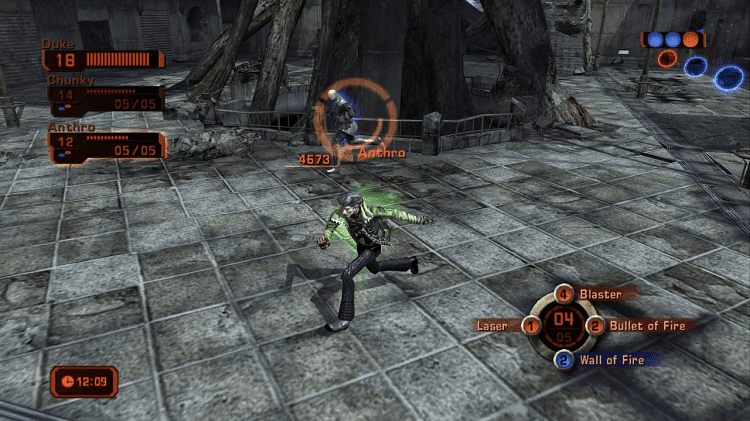
The final difference between the Vandal and the Phantom is their firing rates. The Vandal can shoot 9.75 rounds per second, while the Phantom can fire 11. This slight difference in mechanics makes a minute but considerably impacts how long you strafe and shoot in Valorant.
The timing in your strafe isn’t the same when you’re using a Vandal or a Phantom – so make sure you practice the mechanics in the range. I’ve found that firing 2 or 3 bullets with the Vandal is the perfect number of rounds without introducing recoil or standing still for too long.
Quick bursts of 3 or 4 shots are the ideal range for the Phantom. I also pre-fire corners much more with a Phantom than with a Vandal because I know that the Phantom’s spray resets quicker with a higher firing rate and more bullets in its magazine.
Using quick bursts this way is perfect for Valorant because of the slowness applied when you hit somebody. While it may take you 1 or 2 strafes to get the kill, you’re much harder to eliminate and slow down when you strafe.
Choosing Between The Two
I’ve talked about the pros and cons of each gun and touched on a little about the different situations where one is better than the other. In this section, I wanted to give you a better idea of questions that you should be asking yourself to justify a Phantom or Vandal purchase.
1. What’s The Opponent’s Money Situation?
When buying, many people only consider the team’s economy, but that doesn’t make sense with the Vandal and Phantom as the two rifles have precisely the exact cost: 2900 credits.
Instead, it would help if you looked at your enemy’s money situation and decided on that. If, for example, you’re looking to buy a rifle in their save round, I always like to acknowledge the Phantom, given that it shoots better and is more effective in close-quarter combat. The damage fall-off doesn’t impact you as much because the enemy is unlikely to have full shields anyway.
The same logic holds when the enemy is on a half or force buy. In these cases, the Phantom is the far superior gun, given the minimal impact the damage fall-off has.
When the enemy has enough to buy fully, you should go with whatever gun you’re more comfortable with.
2. What Map Are You On?
Some maps are more open than others. Some angles are longer than others. That’s just the way map design works.
When choosing between the Phantom and the Vandal, you should consider the map you’re on and the angles you want to hold. If you’re holding long angles, you might think about using the Vandal and scoping in to get a more precise shot. This works excellent for maps like Fracture, Bind, Breeze, and Ascent, which have tons of long angles for you to play with.
For more advanced players, consider what angles you’re looking to pre-fire. Using our A main on Ascent example, you might be unfortunate enough to predict the A player peeking early into main, land your pre-fire, but leave your opponent with ten hp given the damage fall off. I love peeking into these angles and using the sights with a Vandal for those clean, “clippable” one-taps.
3. How Comfortable Are You With The Gun?
Knowing which gun to use will only do little if you know how to use it. I mentioned earlier how the different firing rates slightly change how you play and shoot with the gun. This contributes to your overall comfort with the weapon.
The same holds for spraying with the gun. If you don’t know how to control the gun’s recoil, don’t use it – unless you’re ScreaM or Yay and can perfectly perform micro adjustments with your crosshair.
For example, I’m much more confident in clearing close angles and peeking corners using a Phantom than with a Vandal. On the other hand, I’m much more confident holding A showers and B long in Bind with a scoped Vandal than I am with a Phantom.
The gun you hold feeds your confidence, which is definitively critical in your decision-making. The abilities in Valorant can kill, but the majority of kills you’ll make will be with your gun. It would help if you had the confidence to swing out and either take first contact or trade your teammate when necessary.
4. What Type of Agent Are You?
The final thing to consider is your role on the team. Valorant has four significant roles: duelist, controller, sentinel, and initiator.
Duelists and controllers, in my opinion, benefit more from the Phantom, while sentinels and initiators benefit more from the Vandal. Of course, in pro play, players can use different guns depending on their feelings.
But let me explain my thought process.
Duelists are more likely to take close-quarter combat. They’re tasked with clearing corners and seeking engagements for the team. They should be able to shoot, strafe, reset, and burst again – all of which the Phantom allows.
Controllers are more likely to capitalize on their smokes and spam enemies. When I play Smoke, I love peeking out right before the smoke sets to get a general idea of where the enemies are and spam into them.
Sentinels and Initiators are likelier to play the role of second entry and trade their duelists. Long engagements become a more probable occurrence purely because they’re standing farther away.
Alternatives To Consider
If you’re not feeling the Phantom or the Vandal, here are some great alternative guns you may want to start practicing.
Operator
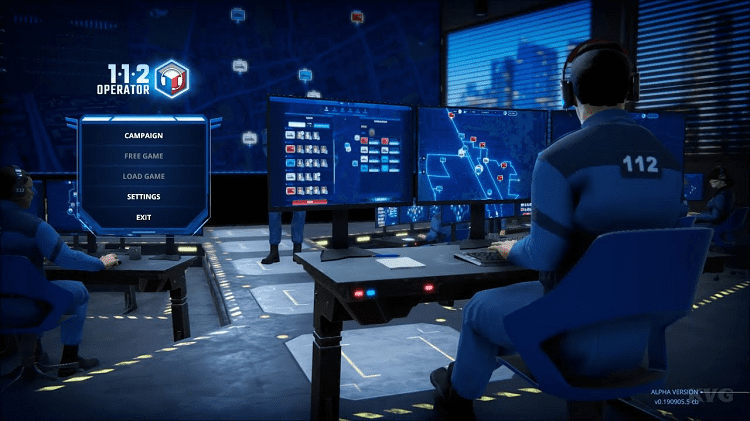
The operator is Valorant’s high-cost sniper rifle with a double scope for extra accuracy. It’s a one-shot kill weapon that can easily turn the tides of the game into the right hands.
Odin
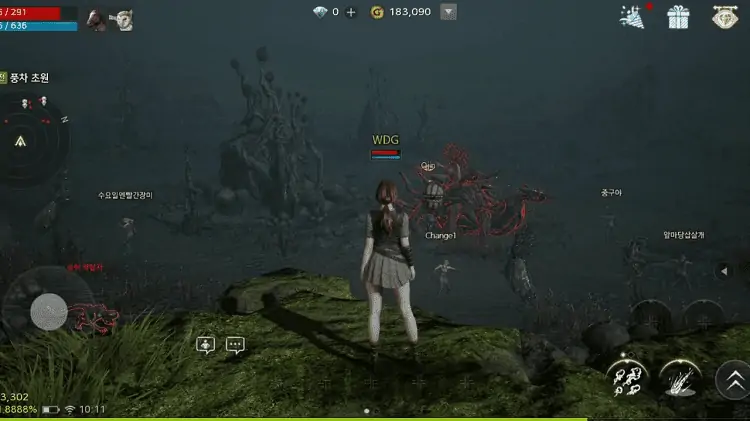
The Odin is Valorant’s machine gun. Unlike other firearms, its 100-round magazine increases its fire rate over the time it is fired. Use this gun at your peril, as its lower mobility, equipment, and reload speed make you an easy target for highly skilled players. I love this gun for maps like Ascent, where I know a lot of walls are paper thin and easily “spammable.”
Guardian

The Guardian is the Vandal’s cheaper semi-automatic cousin. It’s effective in long-range fights and has higher penetration while costing only 2250. Because it’s only semi-automatic, ensure you’re warmed up and deadly accurate before using the gun.
Valorant Phantom vs Vandal: FAQs
Question: Is the Phantom better than the Vandal?
Answer: The Phantom has a suppressor, a higher fire rate, and a bigger magazine than the Vandal. However, the damage drop-off makes the Vandal more popular among professional players.
Question: Do Pros Prefer Vandal or Phantom?
Answer: In Valorant Champions 2022, the players picked the Vandal 44.52% of the time, while the Phantom was chosen 15.19%. This could be a direct result of the Chamber meta which means that players had to eliminate the opponent quickly else they teleport and escapes.

